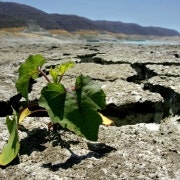July checks in as 4th warmest on record
New US National Climatic Data Center data show that last month was the fourth-warmest July on record worldwide, even though two giant cool spots in the Northern Hemisphere – one over Siberia and the other over the US Midwest – made it easy for people living there to think that summer 2014 has been a mild one.
 Credit: NOAA
Credit: NOAA
The world’s fourth-warmest July comes just after the globe’s warmest June, which was driven mostly by the hottest ocean temperatures since record keeping began 130 years ago. This year is on track to become the earth’s third-warmest year in on record.
The combined average temperature over land and ocean surfaces last month was 0.67 degrees Celsius above the 20th century average of 15.75 degrees, NCDC data show.
Sea surface temperatures last month were about 1°F above the 20th century average, tying 2009 as the warmest July on record. The global land surface temperature was the 10th highest for July since recordkeeping began, but the coolest since 2009.
All this warmth is connected with an increase in greenhouse gases in the atmosphere worldwide caused primarily by human carbon dioxide emissions, which continue their ongoing rise.
Other agencies in the US, Japan and Europe that calculate global average temperatures have wildly different results for last month’s ranking of the warmest Julys on record.
NASA data, for example, place July 2014 as the 11th warmest on record, tying with July 2013. Japan’s meteorological agency ranks last month as the second-warmest on record globally, said Deke Arndt, chief of the NCDC’s Climate Modeling Branch in Asheville, NC.
The difference in the rankings is based on the methods each agency uses to fill in gaps in data for places such as the Middle East and the poles where temperatures are not monitored, he said. NASA is aggressive in filling those gaps in data, whereas scientists in Japan and the United Kingdom are more conservative, each one reaching different results for global average temperatures for a given month, Arndt said.
NASA scientists were unavailable for comment.
“There are four unique approaches to try to measure a really complex thing,” Arndt said. “In the long run we do see month-to-month differences.”
While the data may differ month to month, each agency is showing the same trend: the earth is warming.
“We all see the same signal,” Arndt said. “All datasets singing same song, but hitting different notes along the way.”

Credit: NOAA
NCDC data show that July 2014 was the 38th consecutive July and 353rd consecutive month with a global average temperature above the 20th century average. The last time any month’s global average temperature dipped below the 20th century average was February 1985.
Regardless whether last month was the second-warmest or 11th-warmest on record, the bottom line for July is that overall, more above-average temperatures are being recorded than below-average temperatures.
This is an edited extract of an article originally published by Climate Central. Reproduced with permission.
















